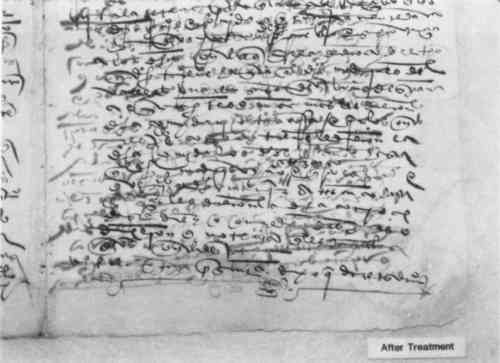THE EXAMINATION AND CONSERVATION TREATMENT OF THE LIBRARY OF CONGRESS HARKNESS 1531 HUEJOTZINGO CODEXSYLVIA RODGERS ALBRO, & THOMAS C. ALBRO
7 TREATMENT OF THE MANUSCRIPT TEXTTHE SEWING structure was taken apart by cutting the threads. The threads were saved for study, and a sewing model was constructed to illustrate the original structure. A new collation of the manuscript was made. Once the leaves had been separated, they were housed temporarily in polyester film sleeves for protection during handling and to permit a complete study of watermarks without fingering the papers. The leaves were lightly dry cleaned with grated Staedtler Mars plastic eraser crumbs. Tests with water and water-alcohol mixtures indicated that the ink would sink further in the paper with any aqueous treatment, adding to the difficulty of reading the text, which already showed considerable strike-through. Aqueous treatment also risked creating more breaks in the sections of already-riddled paper due to the physical stresses of expansion and contraction. A nonaqueous treatment was selected to give the material an alkaline reserve. The leaves were immersed in methyl magnesium carbonate solution (Library of Congress 1977), and this treatment brought the surface pH of the papers up to a range of 6.6–7.4. Leaves with pressure–sensitive tapes were treated first with tetrahydrafuran (THF). After peeling the dried tape carrier away, the leaves were immersed in the solvent to remove the adhesive. To remove additional adhesive staining the leaves were sprayed with THF locally using an air-brush and the suction table. Treatment of these leaves with the methyl magnesium carbonate followed the stain removal. Flexibility and ease of turning the leaves were considered top priorities in the practice of filling and mending. Edge tears and areas of loss in each leaf were repaired with Japanese papers, toned where necessary with Winsor & Newton acrylic pigments to match the original. With the help of a micrometer, layers of kizukishi, usumino, uda and tengujo paper were used to approximate the thickness of the manuscript paper (fig. 7). Determining the precise laminate structure for each fill was important so that new stresses would not be introduced when sections were sewn together again.
A number of different techniques were investigated for mending the ink-damaged papers. Library of Congress heat-set tissue, toned with acrylic pigments, was selected as |
